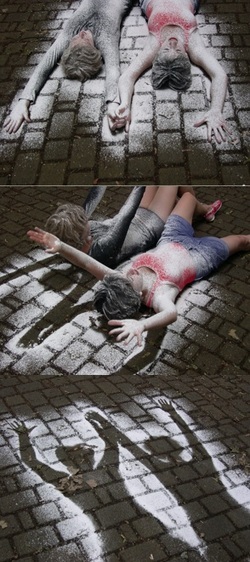Präsenz ist ein wichtiger Faktor im Projekt KULTURPARK, mit dem wir uns oft und international in Berlin 2012 auseinandergesetzt haben und zwar in allen Aspekten. Präsenz, die sowohl für die Entstehung einer Gemeinschaft als auch für das Heraustreten des Individuellen essentiell ist. Unter der langen Liste der im Kontext von KULTURPARK aktivierter Projekte gibt es uns die Gelegenheit, einen Beitrag zum Verständnis der Zeit und der Rolle von Präsenz und Aufmerksamkeit zu liefern mit dem Ziel, die vielfältigen Möglichkeiten, wie diese unser Denken verändern, während wir sie wahrnehmen, zu thematisieren.
Häufig wenden wir uns der Gegenwart zu, wenn ein Eindruck uns auf vielfältige Weise anspricht und so viel in uns auslöst, dass wir das Andere um uns herum vergessen. Wissenschaftler haben erwiesen, dass es oft genug damit zusammenhängt, dass dies bedeutet, dass das Gehirn optimal ausgelastet wird. Vom Psychologen Mihaly Csiksyzentmihalyi[1] kennt man Untersuchungen, in denen man ganz gegenwärtig ist, die volle Aufmerksamkeit hat; er hat sich damit einen Namen gemacht, indem er einen Begriff für diese Erfahrung seiner Probanden prägte, die er „Flow“ nannte. Inzwischen ist geklärt, dass sich dieser „Zustand höchster Präsenz“ nicht ausschließlich mit der Arbeit verbunden sein muss. Nur wenn Wahrnehmung und Verstand ausgelastet sind, die Aufgabe die richtige Schwierigkeit hat, sind wir zu völliger Konzentration imstande. Die automatische Steuerung der Aufmerksamkeit sorgt dann von selber dafür, dass wir beim Wahrnehmen in der Gegenwart bleiben.
Es kommt vor allem darauf an, die optimale Informationsdichte im Gehirn herbeizusteuern als Folge einer Tätigkeit.[2] Eine ähnliche Wirkung haben oft Erlebnisse, die als Symbol für etwas Anderes stehen, die ihrerseits Gedanken und Gefühle auslösen können, dass alle anderen Bewusstseinsinhalte unwichtig erscheinen, ja sogar die Grenzen von Raum und Zeit überwinden. Diese Erfahrung kann eine Begegnung mit der Geschichte oder zum Beispiel Kunst oder die Musik vermitteln.
Dies alles vermochte die Initiativen und unser Think-Tank um KULTURPARK zu erwecken – Zeiträume und Ereignisse, die so stark sind, dass sie unsere Vorstellungskraft ultimativ fordern und einen gezwungen haben, dann vollkommen präsent, den Moment mit wacheren Augen zu sehen.
Wer seine Wahrnehmung trainiert, lernt von der Gegenwart mehr mitzubekommen, und stellt dabei sofort zwei Dinge wahr, erstens: Das Zeitempfinden ändert sich. Eine Stunde voll angeregter Unterhaltung, beispielsweise beim Think-Tank, oder anlässlich der Beiträge bei Radio Espacio, demnach in Unterhaltung mit den Künstlern erscheint einem länger und voller. Dies hängt mit dem Thema der Erinnerung zusammen, das mit KULTURPARK und dem partizipativen Element der nachbar-schaftlichen Kontakte eng verknüpft ist. Zweitens nimmt man wahr, dass die Feststellung freudevoll ist, sie hebt die Stimmung. Denn diese stete Wachsamkeit erfährt das Gehirn als Enthusiasmus: es bleibt die Sentenz - das Gehirn ist eine Zeitmaschine.
Das Empfinden der Zeit und wie jeder für sich die Augenblicke aneinander verkettet, gehört zu unserem Bewusstsein und infolgedessen zu unserer Aufmerksamkeit.[3] Die vergangene Zeit, die Themen um die Wende, die DDR Geschichte, OST-WEST Beziehungen in Berlin, Spreepark und Plänterwald sind inzwischen dank KULTURPARK bei uns in unserer Erinnerung kristallisiert, für immer festgehalten.
Zum Erleben von Zeit wissen wir inzwischen, dass es nicht nur ein Gedächtnis gibt, sondern davon mehrere und dass diese in Stufen eingeteilt sind. Der Weg ins Langzeitgedächtnis geschieht, wenn uns etwas sehr intensiv, länger und wiederholt beschäftigt. Und falls dieser Weg eingeschlagen wird, wissen wir, dass sich die Struktur des Gehirns auch geändert hat. Die Erinnerung formt somit die Persönlichkeit.
KULTURPARK wird selbst zu einer Blitzlichterinnerung, im Sinne vom Psychologen Neisser[4], der dieses Bild verwendet, um die Situation zu verdeutlichen, wenn starke Eindrücke beschrieben werden. Als Leitvorstellung gehen nicht nur Wissenschaftler mit Bildern von Marcel Proust in seinem Roman „Auf der Suche nach der verlorenen Zeit“ um, wenn sich der Autor an eine Glocke aus seiner Kindheit erinnert und ihm auffällt, dass er den Klang immer noch im Ohr hat.
KULTURPARK betrachtet traumatische Momente, Wendepunkte, Krisen, Ereignisse – die jene Momente prägen, an denen sich die Zeit verändert. Es gibt dem Blick auf unser eigenes Denken eine besondere Perspektive. Die Choreographie[5] von KULTURPARK bringt uns diese Vorkommnisse nah und vermittelt ein neues kulturwissenschaftliches Phänomen geboren aus dem Prozessualen. Jeder dieser Positionen von Zusammenbruch und Wiederaufbau ist ein Zustand, ein Geisteszustand, und steht in einer spezifischen Beziehung zur Zeit.
Indem KULTURPARK die spezifische Bedeutung eines Ortes, i.e. Spreepark/Plänterwald, Deutschland, DDR und BRD und Berlin innerhalb von Europa betont, verbindet sie die lokale Geschichte und Wirklichkeit eines Ortes mit der Welt und unserer Erinnerung.
Dieta Sixt
[1] Csiksyzentmihalyi, Mihaly, „Flow. Das Geheimnis des Glücks“. Stuttgart, 1992.
[2] Klein, Stefan, „Zeit“, Frankfurt am Main, 2006.
[3] “What the attentional blink demonstrates is the illusory component of our everyday experience of consciousness. We experience the world as one long continuous stream of thoughts, feelings and events, each neatly seguing into the next. But the existence of the attentional blink points to a somewhat different story. Our brains are actually paying attention to one event or thing which swallows up our attention, blocking out other inputs for short periods, then it releases and fixates on something else. In this sense consciousness is less of a smooth stream and more of a bumpy ride.” Kelewijn, Van den Burg, Bronkhorst, Theeuwes, “Attention, Perception, + Psychophysics”, Amsterdam, 2008.
[4] Neisser, Ulrich, „Cognitive Psychology“, New York, 1967.
[5] Etymologisch die Notation der Bewegungen einer Gruppe von Tänzern, die die Bühne betreten und wieder verlassen – wird in jüngster Zeit im Zusammenhang mit gemeinsamer Partizipation verwendet.

 RSS Feed
RSS Feed